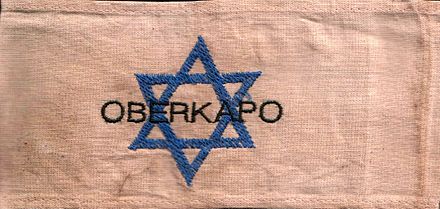
[Photo: Oberkapo armband – Wikipedia]
- Joseph Paal – found guilty of hanging inmates from the barracks ceiling by their hands for ten to twenty minutes at a time and of beating prisoners until they bled.
- Mordecai Friedman – found guilty of beating inmates who were slow in carrying out their jobs.
- Miriam Goldberg – found guilty of pouring soup on an inmate who during food distribution asked for another potato.
- Elsa Trenk – found guilty of nine instances of striking inmates and ordering individuals to kneel on the ground or pavement for extended periods of time.
These were some of the first verdicts handed down in the trials, which became known as “the kapo trials.” Dan Porat, in his new book, Bitter Reckoning: Israel Tries Holocaust Survivors As Nazi Collaborators, describes three distinct phases of Israel’s kapo trials. In this first, most harsh phase, (August 1950-January 1952), these Jewish functionaries (kapos, members of the Judenrat or Jewish Police) were treated harshly. Prosecutors viewed them as “guilty until proven innocent.” (4) They were treated, by the justice system, on equal footing with actual Nazis. Prosecutors were relentless in adding count after count of alleged crimes to bring before the court. Judges heard the cases and meted out punishments. But the sentences were more lenient than the prosecution requested.
- Joseph Paal – “For his ‘sadistic’ actions, wrote the Judge, Paal deserved life in prison, but because these actions had occurred under the Nazi regime . . . [he was] sentenced . . . to ten years, reduced later by the Supreme Court to five years.” (114)
- Mordecai Friedman – panel of three judges gave him three years in prison. (114)
- Miriam Goldberg – sentenced to ten months in prison but allowed the ten months she had already served in detention awaiting trial to count as time served. The Judge stated “that none of your ‘actions showed that you identified yourself with the Germans. . . and I have no doubt that you are not and you were not wicked . . . I have no doubt that your actions resulted due to the concurrent circumstances of anger [and] disturbances from both sides,’ meaning both supervisors and subordinates. (114)
- Elsa Trenk – sentenced to two years imprisonment, with credit for time served awaiting trial. The Prosecutors had charged Trenk with Crimes Against Humanity (requiring the death penalty) and War Crimes. The Court, however, did not convict Trenk of either these crimes. “The judges determined Israeli law required that for an offense to be considered a war crime it must be a serious one, such as ‘murder, ill-treatment or deportation to forced labour [sic] or for any other purpose, of civilian population of or in occupied territory.’ Trenk had not been found guilty of any serious crimes.” (117-118)
So although the Israeli public, especially the survivor population, wanted revenge and took harsh positions against these Jewish “traitors,” the judges softened the blow, admitting that these Jewish defendants were in a situation that they, having not been there, could not judge based on norms of a democratic society.
A turning point in these cases came with the conviction of Yehezkel Jungster in 1951. Survivors testified that Jungster was a “malicious kapo.” (130) “Already on my first day at work,” testified Yehuda Holtzman, “the defendant punched me and broke two of my teeth.” (130) “[I]f a person did not jump from his bed with the required speed,” David Levkovitch, another survivor explained, “he struck him with his stick. If he found a bed not made exactly as it should be, he would hit him with his stick. . . If he found a pair of shoes not lined up precisely – he would strike.” (130)
The judges in the Jungster case found that the defendant had beat and harmed fellow Jews in the camp, but they dismissed the counts of war crimes, stating: “one cannot convict a person for a war crime when both he and his victims are members of the same persecuted people.” (139)
This rational, however, did not extend to the counts of Crimes Against Humanity. Two of the three judges on the panel in the Jungster trial stated that to rise to a Crime Against Humanity, the “action has to be of a sever nature that might make a person miserable, humiliate him, and inflict on him grave physical or mental torments,’ and ‘the action must be committed against civilians in a wide-scale and systematic manner . . [and] in a way that arouses a revolt of conscience and of human emotions.” (140) Jungster’s actions, they determined met this threshold. His acts were against individuals, but “had been committed on a wide scale” that they were crimes against humanity. “The defendant had allowed himself to be used as a tool in the hands of the barbaric Nazi regime,” the majority opinion held, “[to carry out] its pan to annihilate the Jewish people, and because his actions took place under the Nazi regime in an enemy country, he committed a crime against humanity as defined in the first paragraph of the [Nazi and Nazi Collaborator] law.”(140)
One of the three judges dissented on this point. Judge Joseph Lam, who himself survived Dachau, wrote that the conditions needed for a Crime Against Humanity were not met here. Jungster did not aim to annihilate the Jewish population nor did he commit “inhumane actions.” (140)
Because of the way the Nazi and Nazi Collaborator Law was written, the Judges determined that they had no choice but to impose the death penalty on Jungster. To them, the law stated clearly that if a person was found guilty of Crimes Against Humanity, he or she must be put to death. This outcome gave the zealot prosecutors pause and they realized that this was an unjust result. The prosecutors then instituted a new “rule:” Jewish functionaries would not be charged with Crimes Against Humanity. (142)
In the end, the Supreme Court reversed the finding against Jungster related to Crimes Against Humanity and the death sentence was abated, but they let stand the finding on assault, with a two-year prison term. Jungster did not live to the end of the two-years. His health deteriorated in prison and he died on July 10, 1952.
The Jungster trial’s outcome – death penalty for a Jewish functionary – made people realize that they could not judge these survivors in this harsh – “guilty until proven innocent” – way. The next phase of the kapo trials (February 1952-1957) sees a change of attitude – a bit more of – “who are we to judge?” After the Jungster trial, the editor of Yediyot Acharanot stated: “To judge here those who were there – and precisely by our common laws, that are normal here according to our everyday logic – that is difficult!”(148) Although there was definitely some softening of public and legal opinion towards Jewish functionaries, the “kapo trials” continued.
The next phase of the “kapo trials” saw further changes and a shift in public opinion against Jews who “collaborated” with the Nazis. Stay tuned.


Those crimes are terrible. That was not what I meant when I said this was not black and white. These cases seem to be.
LikeLiked by 1 person
Thanks for your comment – I agree that it is terrible. But I also think that none of these cases are black and white. There is no easy answer to what happened between Jew and Jew in the Shoah. I am of the opinion that we can study and learn, but cannot judge. Karen
LikeLike